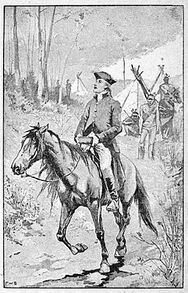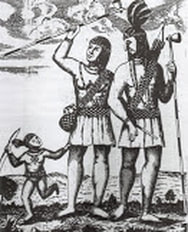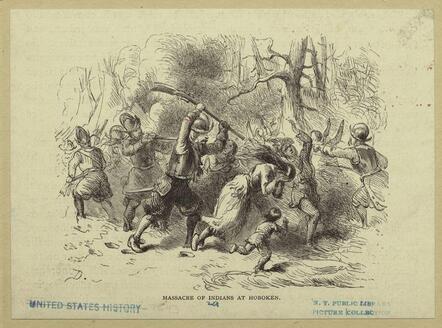* Home
|
|
|
Although the Lenape were known as relatively peaceful tribes who were sometimes called upon by other tribes to mediate or judge disputes, they nonetheless occasionally resorted to violence. Most of these conflicts were provoked by incursions into Lenape territory by other tribes, such as the Mohawk to their north and the Susquehannock to the west. Between 1630 and 1635, the Susquehannock, for example, attacked Lenape villages in southeastern Pennsylvania, forcing many Lenape to escape across the Delaware River into New Jersey. As European explorers and settlers increasingly entered their traditional lands, the Lenape would face a series of new challenges.
|
 Drawing of David Brainerd Image: Wikipedia.org Drawing of David Brainerd Image: Wikipedia.org
Apart from armed conflicts, a more devastating blow to the Lenape population came through the rapid spread of contagious disease, particularly smallpox, resulting from their contacts with Europeans. As their numbers fell, the remaining Lenape gradually developed accommodations with the new white settlers over land claims, and attempted to create trading relationships to maintain their traditional pursuit of trapping. The Lenape sold some of their northern New Jersey lands to the English in 1673 and 1681, but the English also often took land without paying. The Lenapes also had no concept of the ownership of land, and often believed that the transactions they entered simply allowed concurrent use of the land, thus leading to confusion and misunderstandings.
In 1758, at the urging of the Reverend John Brainerd, a minister and missionary who had established a school for Lenape children and sought to convert them to Christianity, New Jersey became the first colony to establish an Indian reservation at Brotherton in Burlington County, but there were only a few hundred Indians remaining and only 200 came to live at the reservation. Brainerd organized the reservation and helped the residents to set up grist and sawmills, which led to naming of the nearby village as Indian Mills. But conditions steadily deteriorated after Brainerd became ill and left Brotherton in 1777 to return to his native Connecticut where he died in 1781. In 1796, the Oneida tribe in New Stockbridge in New York State invited the Brotherton tribe to come live with them--an invitation later accepted by the remaining 85 tribe members, who received partial payment in 1801 from the New Jersey Assembly for the sale of the reservation. In 1802, the last Brotherton chief, Elisha Ahhataina (Lashar Tamar), led twelve rented wagons conveying the tribe and their possessions to join the Oneidas in New York. A few of the tribe chose to stay in New Jersey, residing in local communities of South Jersey and some moving north o the hills of North Jersey and Pennsylvania. Chief Tamar stayed for a time with the Oneidas in New York, but eventually returned to New Jersey and settled on the Woolman farm near the town of Rancocas. In 1832, the New Jersey Legislature appropriated $3,551.23 to pay the remaining Brotherton Indians for the balance of the money from the sale of the Brotherton Reservation; some 40 members of the tribe who had moved to New York then resettled in Statesburg, Wisconsin. Later, some of the tribe moved on to join with the Cherokees and Osages, west of the Mississippi. Some later went to "Indian territory," now Oklahoma, and others emigrated to Canada. A continuing controversy exists over the status of the so-called Ramapough Mountain Indians in the area of Bergen and Passaic counties. Members of this group began in 1979 lobbying for federal recognition as a tribe, following up in 1990 by submitting a formal petition to the US Bureau of Indian Affairs (BIA) under the Indian Gaming Regulatory Act enacted in 1988 which had led to the creation of successful tribal casinos in Connecticut. The petition was rejected by the BIA in 1993, with the BIA justifying the rejection by stating that this community had neither been "viewed as American Indian" nor were its members "descendants of an Indian tribe which historically inhabited a specific area" and that none of the documentation submitted connected the earliest documented ancestors with any of the tribes that once resided in New York or New Jersey. Other historians have argued that those claiming Ramapough heritage are more likely descendants of members of a community of free blacks who were culturally Dutch living on the outskirts of New York City in the 1670s. Despite the federal rejection, in 1980 the New Jersey legislature approved a resolution that "...the Ramapough Mountain People of the Ramapough Mountains of Bergen and Passaic counties, descendants of the Iroquois and Algonquin nations, are hereby designated by the State of New Jersey as the Ramapough Indians." The attempt to seek federal recognition, as well as subsequent efforts to designate the selling of crafts designated as authentic Ramapough products, was also vigorously opposed by the state government and Atlantic City casino interests (led by then Atlantic City casino owner Donald Trump), as primarily motivated by those seeking to allow a tribe-sponsored casino in the lucrative metro-New York City-North Jersey market which would be exempt from New Jersey's casino licensing and regulatory process. In August 2006, after a state park ranger shot and killed a member of the Ramapough group in a confrontation in Ringwood State Park, Governor Jon Corzine formed what has evolved under the name of the New Jersey Commission on American Indian Affairs to investigate issues of civil rights, education, employment, fair housing, environmental protection, health care, infrastructure and equal opportunity confronting members of New Jersey's three indigenous Native American tribes and other New Jersey residents of Native American descent. The group's report delivered in December 2007 cited "lingering discrimination, ignorance of state history and culture, and cynicism in the treatment of Indian people". The Commission continues to operate as a liaison among the tribes and the State and Federal governments and to develop educational and other programs of interest to the community. * The Nanticoke Lenni Lenape * New Jersey Commission on American Indian Affairs * The Ramapo Mountain People, David Steven Cohen * Strangers on the Mountain, 3/1/2010, The New Yorker * Office of Minority and Multicultural Health, NJ Department of Health * Bureau of Indian Affairs, US Department of the Interior * The Decline of the NJ Lenape Indians and the Preservation of its Culture, timetoast.com * Ramapoughs' anger at Donald Trump endures, 7/4/2016, NorthJersey.com |
|
John Kraft, the curator and guide of the Lenape Indian Village at Waterloo, conducts tour of the reconstructed Lenape Village, discussing how the Lenape built their houses, how the men hunted and fished while the women grew vegetables, cooked meals, and raised children, as well as how the way of life changed when European traders began to arrive seeking furs.
Lenape Past and Present - 2021 NJ Historical Commission conference
*
Native Americans * Exploration and Settlement * British colony * Royal governance * Path to Revolution * Revolutionary War * Industrialization * Civil War * Post-War Economy & Reform * Woodrow Wilson as Governor * World War I & 1920s * Great Depression * World War II* Post-War Development * 1960s & Richard Hughes * 1970s & Income tax * 1990s-Whitman & Florio * 9/11 & McGreevey Administration * Codey & Corzine * Chris Christie * Phil Murphy |



